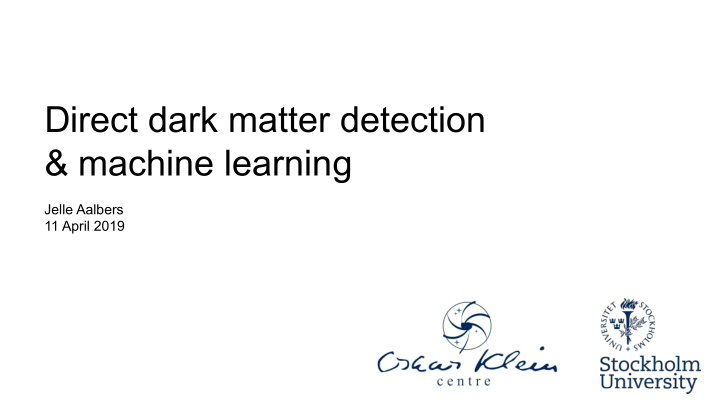



Direct dark matter detection & machine learning Jelle Aalbers 11 April 2019
Part 1 : Introduction to direct detection
… of the parameters of the halo model. Constraining the halo itself with observations is another issue entirely!
q 2 suppressed S pin- I ndependent S pin- D ependent Normal, dominant Smaller but Forget about A 2 enhancement measurable direct detection
PICO SuperCDMS EDELWEISS CRESST CoGeNT DAMA/LIBRA DAMIC COSINE, SABRE SENSEI CCDs XMASS, DEAP Xenon: XENON, LUX/LZ, PandaX Argon: DarkSide, ArDM, WArP 9
Requirements for a DM detector 1. Emit detectable light (photons), charge (electrons) or heat 2. Large mass 3. High atomic number 4. Low-radioactivity 5. Deep underground Future: directional sensitivity
He Ne Ar Kr Xe Nucleons 4 20 40 84 131 Rate x 16 400 1 600 7 056 17 161
XENON collaboration
Image: S. Breur
XENON collaboration
XENON collaboration
Image: L. Grandi
*: proof-of-concept result from my PhD thesis (UvA 2018)
Part 2 : XENON1T data analysis
Data pipeline 23 [https://github.com/XENON1T]
Processor & simulator calibration Mean amplitude (a.u.) S1 waveform matching Time (us) x (cm) Time (us) S1 detection efficiency Keeping the cycle virtuous: - Humans examine processed events S1 detection - Simulator contains (mostly) physical models efficiency - Simulator injects statistical variation, processor must be generic 24 Photons detected by PMTs Processor and simulator: [https://github.com/XENON1T/pax]
Backgrounds Extrinsic Intrinsic 222 Rn progeny (β) 85 Kr (β) Radiogenic γ, β Electronic recoil v-electron scattering 136 Xe ββ Illustration only Radiogenic neutrons Nuclear recoil Coherent ν-nucleus sc. S1/S2 discrimination Cosmogenic (μ-induced) n 85 Kr distillation [arxiv:1612.04284] Gran Sasso mountain Instrumented water shield LXe self-shielding 3.6 km water eq. 10m high, 10m diam. [https://arxiv.org/abs/1406.2374] 25 Other backgrounds: Accidental coincidences Events from unusual regions (gas, cathode)
ER calibration NR calibration Science data This data is from XENON1T’s first science run; we since took a longer run, but the principle is the same.
Want to hear more or discuss about statistical issues in direct detection? Stockholm 31 July - 2 August 2019 Open for abstracts now https://indico.cern.ch/event/769726/
Hogenbirk, E. et al. JINST 13 (2018) no.05, P05016 arXiv:1803.07935
Part 3 : Machine learning
Position reconstruction Can you beat the machine? https://pelssers.github.io/reconstruct/ Legend: TPF : TopPatternFit, likelihood maximizer NN : Neural net (old-style, few-layer, fully-connected) RWM : Iterated weighted mean over shrinking set MP : Maximum PMT WM : Weighted mean Javascript game by Bart Pelssers
Super-unofficial plot
Work by Bart Pelssers and Umberto Simola Reconstruction using BOLFI JINST 14 (2019) / arXiv:1810.09930 Basic idea: Sample position from prior/posterior Run simulator Measure goodness of fit (summary stat.) Update posterior Repeat ~15% improvement over likelihood fitter (because the likelihood is incomplete)
Work by Bart Pelssers and Justin Alsing Using Pydelfi: arxiv:1903.00007 Density Estimation Likelihood Free Inference Emulate simulator with deep neural net Pydelfi learns sampling distribution p(data | parameters) Preliminary Comparable to BOLFI in accuracy but much faster.
Learning light maps: fitting Work from the LUX collaboration JINST 13 (2018), arXiv:1710.02752 Reconstruct positions Fit light maps Repeat
Learning light maps: fitting Work from the LUX collaboration JINST 13 (2018), arXiv:1710.02752 5mm wires!
Work in progress Learning light maps: embedding Jelle Aalbers, Chris Tunnell PCA Colors: TPF positions NOT truth values!! LLE
Work in progress Learning light maps: embedding Jelle Aalbers, Chris Tunnell No cables are swapped!
Fiducial mass XENONnT, LZ Several tonnes Low-energy background Fine print: Most experiments have different runs, often each with different fiducial volumes and background levels. LUX has a position-dependent likelihood, so there is more than one relevant background level in their fiducial volume(s). On this slide keV should be read as keV electronic recoil equivalent (keVee). XENON10’s fiducial low-energy ER background was 600 events/(ton keV day). The “march of progress” is a misleading caricature of the rich and branching evolution of the great apes. Any resemblance between the ape-men and scientists working in the field is purely accidental.
Rare radioactive decays t 1/2 = 10 21 - 10 22 years! Double beta decay Neutrinoless double beta decay
Elastic neutrino-nucleus scattering Solar neutrinos Galactic supernovae 8 B
E. Aprile et. al. PRL 122, 141301 [arXiv 1902.03234]
(Fine print: these are only the simplest thermal-relic WIMP models) Data from M. Escudero et al. JCAP 2016.12 pp. 029–029 .[arXiv:1609.09079]
Signal efficiency Dominant signal loss is from 3 PMT S1 coincidence requirement Example WIMP spectrum shown here is for m = 50 GeV Backup slide 49
Recommend
More recommend